Recent Findings from Heavy-Flavor Angular Correlation Measurements in Hadronic Collisions
Abstract
1. Introduction
2. Study of Heavy Quark Production Mechanisms
3. Characterizing the Fragmentation of Heavy Quarks into Jets
4. Heavy Quark Energy Loss and Redistribution
5. Small-System Collective-like Effects for Heavy Quarks
6. Summary
Author Contributions
Funding
Data Availability Statement
Conflicts of Interest
References
- Cacciari, M.; Greco, M.; Nason, P. The pT spectrum in heavy-flavour hadroproduction. J. High Energy Phys. 1998, 1998, 007. [Google Scholar] [CrossRef]
- Cacciari, M.; Frixione, S.; Nason, P. The pT spectrum in heavy flavor photoproduction. J. High Energy Phys. 2001, 2001, 006. [Google Scholar] [CrossRef]
- Kniehl, B.A.; Kramer, G.; Schienbein, I.; Spiesberger, H. Reconciling open charm production at the Fermilab Tevatron with QCD. Phys. Rev. Lett. 2006, 96, 012001. [Google Scholar] [CrossRef] [PubMed]
- Kniehl, B.A.; Kramer, G.; Schienbein, I.; Spiesberger, H. Finite-mass effects on inclusive B meson hadroproduction. Phys. Rev. D 2008, 77, 014011. [Google Scholar] [CrossRef]
- Aggarwal, M.M. et al. [STAR Collaboration] Measurement of the Bottom contribution to non-photonic electron production in p + p collisions at = 200 GeV. Phys. Rev. Lett. 2010, 105, 202301. [Google Scholar] [CrossRef]
- Adare, A. et al. [PHENIX Collaboration] Measurement of Bottom versus Charm as a Function of Transverse Momentum with Electron-Hadron Correlations in p + p Collisions at = 200 GeV. Phys. Rev. Lett. 2009, 103, 082002. [Google Scholar] [CrossRef] [PubMed]
- Adare, A. et al. [PHENIX Collaboration] Measurement of high-pT single electrons from heavy-flavor decays in p + p collisions at = 200 GeV. Phys. Rev. Lett. 2006, 97, 252002. [Google Scholar] [CrossRef]
- Acosta, D. et al. [CDF II Collaboration] Measurement of prompt charm meson production cross sections in collisions at = 1.96 TeV. Phys. Rev. Lett. 2003, 91, 241804. [Google Scholar] [CrossRef]
- Cacciari, M.; Nason, P. Charm cross-sections for the Tevatron Run II. J. High Energy Phys. 2003, 2003, 006. [Google Scholar] [CrossRef]
- Acosta, D. et al. [CDF Collaboration] Measurement of the J/ψ meson and b-hadron production cross sections in collisions at = 1960 GeV. Phys. Rev. D 2005, 71, 032001. [Google Scholar] [CrossRef]
- Acharya, S. et al. [ALICE Collaboration] Measurement of electrons from semileptonic heavy-flavour hadron decays at midrapidity in pp and Pb–Pb collisions at = 5.02 TeV. Phys. Lett. B 2020, 804, 135377. [Google Scholar] [CrossRef]
- Sirunyan, A.M. et al. [CMS Collaboration] Nuclear modification factor of D0 mesons in PbPb collisions at = 5.02 TeV. Phys. Lett. B 2018, 782, 474–496. [Google Scholar] [CrossRef]
- Aaij, R. et al. [LHCb Collaboration] Measurements of prompt charm production cross-sections in pp collisions at = 13 TeV. J. High Energy Phys. 2016, 2016, 159, Erratum in J. High Energy Phys. 2016, 2016, 13; Erratum in J. High Energy Phys. 2017, 2017, 74. [Google Scholar] [CrossRef]
- Acharya, S. et al. [ALICE Collaboration] Measurement of inclusive charged-particle b-jet production in pp and p–Pb collisions at = 5.02 TeV. J. High Energy Phys. 2022, 2022, 178. [Google Scholar] [CrossRef]
- Acharya, S. et al. [ALICE Collaboration] Measurement of the production of charm jets tagged with D0 mesons in pp collisions at = 5.02 and 13 TeV. arXiv 2022, arXiv:2204.10167. [Google Scholar]
- Acharya, S. et al. [ALICE Collaboration] Measurement of D0, D+, D*+ and production in pp collisions at = 5.02 TeV with ALICE. Eur. Phys. J. C 2019, 79, 388. [Google Scholar] [CrossRef]
- Acharya, S. et al. [ALICE Collaboration] Production of muons from heavy-flavour hadron decays in pp collisions at = 5.02 TeV. J. High Energy Phys. 2019, 2019, 008. [Google Scholar] [CrossRef]
- Acharya, S. et al. [ALICE Collaboration] Measurement of beauty and charm production in pp collisions at = 5.02 TeV via non-prompt and prompt D mesons. J. High Energy Phys. 2021, 2021, 220. [Google Scholar] [CrossRef]
- Abelev, B. et al. [ALICE Collaboration] Heavy flavour decay muon production at forward rapidity in pp collisions at = 7 TeV. Phys. Lett. B 2012, 708, 265–275. [Google Scholar] [CrossRef]
- Abelev, B. et al. [ALICE Collaboration] Measurement of charm production at central rapidity in pp collisions at = 2.76 TeV. J. High Energy Phys. 2012, 2012, 191. [Google Scholar] [CrossRef]
- Abelev, B. et al. [ALICE Collaboration] Measurement of electrons from semileptonic heavy-flavour hadron decays in pp collisions at = 7 TeV. Phys. Rev. D 2012, 86, 112007. [Google Scholar] [CrossRef]
- Aaij, R. et al. [LHCb collaboration] Measurements of prompt charm production cross-sections in pp collisions at = 5 TeV. J. High Energy Phys. 2017, 2017, 147. [Google Scholar] [CrossRef]
- Abelev, B. et al. [ALICE Collaboration] Measurement of electrons from beauty hadron decays in pp collisions at = 7 TeV. Phys. Lett. B 2013, 721, 13–23, Erratum in Phys. Lett. B 2016, 763, 507–509. [Google Scholar] [CrossRef]
- Abelev, B. et al. [ALICE Collaboration] Measurement of electrons from semileptonic heavy-flavor hadron decays in pp collisions at = 2.76 TeV. Phys. Rev. D 2015, 91, 012001. [Google Scholar] [CrossRef]
- Aaij, R. et al. [LHCb collaboration] Measurement of the B± production cross-section in pp collisions at = 7 TeV. J. High Energy Phys. 2012, 2012, 093. [Google Scholar] [CrossRef]
- Aad, G. et al. [ATLAS collaboration] Measurement of the b-hadron production cross section using decays to D*μ−X final states in pp collisions at = 7 TeV with the ATLAS detector. Nucl. Phys. B 2012, 864, 341–381. [Google Scholar] [CrossRef]
- Aad, G. et al. [ATLAS collaboration] Measurement of the differential cross-section of B+ meson production in pp collisions at = 7 TeV at ATLAS. J. High Energy Phys. 2013, 2013, 042. [Google Scholar] [CrossRef]
- Chatrchyan, S. et al. [ATLAS collaboration] Measurement of the cross section for production of X, decaying to muons in pp collisions at = 7 TeV. J. High Energy Phys. 2012, 2012, 110. [Google Scholar] [CrossRef]
- Khachatryan, V. et al. [CMS Collaboration] Measurement of the B+ Production Cross Section in pp collisions at = 7 TeV. Phys. Rev. Lett. 2011, 106, 112001. [Google Scholar] [CrossRef]
- Chatrchyan, S. et al. [CMS Collaboration] Measurement of the B0 production cross section in pp collisions at = 7 TeV. Phys. Rev. Lett. 2011, 106, 252001. [Google Scholar] [CrossRef] [PubMed]
- Chatrchyan, S. et al. [CMS Collaboration] Measurement of the Production Cross Section with → J/ψϕ Decays in pp collisions at = 7 TeV. Phys. Rev. D 2011, 84, 052008. [Google Scholar] [CrossRef]
- Khachatryan, V. et al. [CMS Collaboration] Measurement of the total and differential inclusive B+ hadron cross sections in pp collisions at = 13 TeV. Phys. Lett. B 2017, 771, 435–456. [Google Scholar] [CrossRef]
- Cacciari, M.; Frixione, S.; Houdeau, N.; Mangano, M.L.; Nason, P.; Ridolfi, G. Theoretical predictions for charm and bottom production at the LHC. J. High Energy Phys. 2012, 2012, 137. [Google Scholar] [CrossRef]
- Kniehl, B.A. Inclusive production of heavy-flavored hadrons at NLO in the GM-VFNS. In Proceedings of the 16th International Workshop on Deep Inelastic Scattering and Related Subjects (DIS 2008), London, UK, 7–11 April 2008; p. 195. [Google Scholar] [CrossRef][Green Version]
- Kniehl, B.A.; Kramer, G.; Schienbein, I.; Spiesberger, H. Inclusive B-Meson Production at the LHC in the GM-VFN Scheme. Phys. Rev. D 2011, 84, 094026. [Google Scholar] [CrossRef]
- Bolzoni, P.; Kramer, G. Inclusive lepton production from heavy-hadron decay in pp collisions at the LHC. Nucl. Phys. B 2013, 872, 253–264, Erratum in Nucl. Phys. B 2013, 876, 334–337. [Google Scholar] [CrossRef]
- Bolzoni, P.; Kramer, G. Inclusive charmed-meson production from bottom hadron decays at the LHC. J. Phys. G Nucl. Part. Phys. 2014, 41, 075006. [Google Scholar] [CrossRef][Green Version]
- Adare, A. et al. [PHENIX Collaboration] Heavy Quark Production in p + p and Energy Loss and Flow of Heavy Quarks in Au + Au Collisions at = 200 GeV. Phys. Rev. C 2011, 84, 044905. [Google Scholar] [CrossRef]
- Abelev, B.I. et al. [STAR Collaboration] Transverse momentum and centrality dependence of high-pT non-photonic electron suppression in Au + Au collisions at = 200 GeV. Phys. Rev. Lett. 2007, 98, 192301, Erratum in Phys. Rev. Lett. 2011, 106, 159902. [Google Scholar] [CrossRef]
- Adamczyk, L. et al. [STAR Collaboration] Elliptic flow of electrons from heavy-flavor hadron decays in Au + Au collisions at = 200, 62.4, and 39 GeV. Phys. Rev. C 2017, 95, 034907. [Google Scholar] [CrossRef]
- Acharya, S. et al. [ALICE Collaboration] Prompt D0, D+, and D*+ production in Pb–Pb collisions at = 5.02 TeV. J. High Energy Phys. 2022, 2022, 174. [Google Scholar] [CrossRef]
- Acharya, S. et al. [ALICE Collaboration] Measurement of prompt -meson production and azimuthal anisotropy in Pb–Pb collisions at = 5.02 TeV. Phys. Lett. B 2022, 827, 136986. [Google Scholar] [CrossRef]
- Acharya, S. et al. [ALICE Collaboration] D-meson azimuthal anisotropy in midcentral Pb-Pb collisions at = 5.02 TeV. Phys. Rev. Lett. 2018, 120, 102301. [Google Scholar] [CrossRef] [PubMed]
- Acharya, S. et al. [ALICE Collaboration] Transverse-momentum and event-shape dependence of D-meson flow harmonics in Pb–Pb collisions at = 5.02 TeV. Phys. Lett. B 2021, 813, 136054. [Google Scholar] [CrossRef]
- Braaten, E.; Thoma, M.H. Energy loss of a heavy fermion in a hot plasma. Phys. Rev. D 1991, 44, 1298–1310. [Google Scholar] [CrossRef]
- Peshier, A. The QCD collisional energy loss revised. Phys. Rev. Lett. 2006, 97, 212301. [Google Scholar] [CrossRef]
- Peigne, S.; Peshier, A. Collisional energy loss of a fast heavy quark in a quark-gluon plasma. Phys. Rev. D 2008, 77, 114017. [Google Scholar] [CrossRef]
- Gyulassy, M.; Wang, X.N. Multiple collisions and induced gluon Bremsstrahlung in QCD. Nucl. Phys. B 1994, 420, 583–614. [Google Scholar] [CrossRef]
- Baier, R.; Dokshitzer, Y.L.; Peigne, S.; Schiff, D. Induced gluon radiation in a QCD medium. Phys. Lett. B 1995, 345, 277–286. [Google Scholar] [CrossRef]
- Gyulassy, M.; Levai, P.; Vitev, I. NonAbelian energy loss at finite opacity. Phys. Rev. Lett. 2000, 85, 5535–5538. [Google Scholar] [CrossRef] [PubMed]
- Dokshitzer, Y.L.; Kharzeev, D.E. Heavy quark colorimetry of QCD matter. Phys. Lett. B 2001, 85, 199–206. [Google Scholar] [CrossRef]
- Armesto, N.; Salgado, C.A.; Wiedemann, U.A. Low-pT collective flow induces high-pT jet quenching. Phys. Rev. C 2005, 72, 064910. [Google Scholar] [CrossRef]
- Zhang, B.W.; Wang, E.; Wang, X.N. Heavy quark energy loss in nuclear medium. Phys. Rev. Lett. 2004, 93, 072301. [Google Scholar] [CrossRef]
- Nahrgang, M.; Aichelin, J.; Gossiaux, P.B.; Werner, K. Azimuthal correlations of heavy quarks in Pb + Pb collisions at = 2.76 TeV at the CERN Large Hadron Collider. Phys. Rev. C 2014, 90, 024907. [Google Scholar] [CrossRef]
- Cao, S.; Qin, G.Y.; Bass, S.A. Modeling of heavy-flavor pair correlations in Au-Au collisions at 200A GeV at the BNL Relativistic Heavy Ion Collider. Phys. Rev. C 2015, 92, 054909. [Google Scholar] [CrossRef]
- Eskola, K.J.; Paukkunen, H.; Salgado, C.A. EPS09: A New Generation of NLO and LO Nuclear Parton Distribution Functions. J. High Energy Phys. 2009, 2009, 65. [Google Scholar] [CrossRef]
- de Florian, D.; Sassot, R. Nuclear parton distributions at next-to-leading order. Phys. Rev. D 2004, 69, 074028. [Google Scholar] [CrossRef]
- Hirai, M.; Kumano, S.; Nagai, T.H. Determination of nuclear parton distribution functions and their uncertainties in next-to-leading order. Phys. Rev. C 2007, 76, 065207. [Google Scholar] [CrossRef]
- Fujii, H.; Watanabe, K. Heavy quark pair production in high energy pA collisions: Open heavy flavors. Nucl. Phys. A 2013, 920, 78–93. [Google Scholar] [CrossRef]
- Tribedy, P.; Venugopalan, R. QCD saturation at the LHC: Comparisons of models to p + p and A + A data and predictions for p + Pb collisions. Phys. Lett. B 2012, 710, 125–133, Erratum in Phys. Lett. B 2013, 718, 1154. [Google Scholar] [CrossRef]
- Albacete, J.L.; Dumitru, A.; Fujii, H.; Nara, Y. CGC predictions for p + Pb collisions at the LHC. Nucl. Phys. A 2013, 897, 1–27. [Google Scholar] [CrossRef][Green Version]
- Rezaeian, A.H. CGC predictions for p+A collisions at the LHC and signature of QCD saturation. Phys. Lett. B 2013, 718, 1058–1069. [Google Scholar] [CrossRef]
- Accardi, A.; Arleo, F.; Brooks, W.K.; D’Enterria, D.; Muccifora, V. Parton Propagation and Fragmentation in QCD Matter. Riv. Nuovo Cim. 2009, 32, 439–554. [Google Scholar] [CrossRef]
- Salgado, C.A.; Alvarez-Muñiz, J.; Arleo, F.; Armesto, N.; Botje, M.; Cacciari, M.; Campbel, J.; Carli, C.; Cole, B.; D’Enterria, D.; et al. Proton-Nucleus Collisions at the LHC: Scientific Opportunities and Requirements. J. Phys. G 2012, 39, 015010. [Google Scholar] [CrossRef]
- Vogt, R. Heavy Flavor Azimuthal Correlations in Cold Nuclear Matter. Phys. Rev. C 2018, 98, 034907. [Google Scholar] [CrossRef]
- Vogt, R. kinematic correlations in cold nuclear matter. Phys. Rev. C 2020, 101, 024910. [Google Scholar] [CrossRef]
- Marquet, C.; Roiesnel, C.; Taels, P. Linearly polarized small-x gluons in forward heavy-quark pair production. Phys. Rev. D 2018, 97, 014004. [Google Scholar] [CrossRef]
- Aidala, C. et al. [PHENIX Collaboration] Measurements of μμ pairs from open heavy flavor and Drell-Yan in p + p collisions at = 200 GeV. Phys. Rev. D 2019, 99, 072003. [Google Scholar] [CrossRef]
- Aaboud, M. et al. [ATLAS Collaboration] Measurement of b-hadron pair production with the ATLAS detector in proton-proton collisions at = 8 TeV. J. High Energy Phys. 2017, 2017, 62. [Google Scholar] [CrossRef]
- Khachatryan, V. et al. [CMS Collaboration] Measurement of Angular Correlations based on Secondary Vertex Reconstruction at = 7 TeV. J. High Energy Phys. 2011, 2011, 136. [Google Scholar] [CrossRef]
- Aaij, R. et al. [LHCb Collaboration] Observation of double charm production involving open charm in pp collisions at = 7 TeV. J. High Energy Phys. 2012, 2012, 141, Addendum in J. High Energy Phys. 2014, 2014, 108. [Google Scholar] [CrossRef]
- Aaij, R. et al. [LHCb Collaboration] Study of correlations in high energy proton-proton collisions. J. High Energy Phys. 2017, 2017, 30. [Google Scholar] [CrossRef]
- Aaij, R. et al. [LHCb Collaboration] Observation of Enhanced Double Parton Scattering in Proton-Lead Collisions at = 8.16 TeV. Phys. Rev. Lett. 2020, 125, 212001. [Google Scholar] [CrossRef] [PubMed]
- Sjostrand, T.; Mrenna, S.; Skands, P.Z. PYTHIA 6.4 Physics and Manual. J. High Energy Phys. 2006, 2006, 26. [Google Scholar] [CrossRef]
- Frixione, S.; Nason, P.; Ridolfi, G. A Positive-weight next-to-leading-order Monte Carlo for heavy flavour hadroproduction. J. High Energy Phys. 2007, 2007, 126. [Google Scholar] [CrossRef]
- Kom, C.H.; Kulesza, A.; Stirling, W.J. Pair Production of J/psi as a Probe of Double Parton Scattering at LHCb. Phys. Rev. Lett. 2011, 107, 082002. [Google Scholar] [CrossRef] [PubMed]
- Baranov, S.P.; Snigirev, A.M.; Zotov, N.P. Double heavy meson production through double parton scattering in hadronic collisions. Phys. Lett. B 2011, 705, 116–119. [Google Scholar] [CrossRef][Green Version]
- Novoselov, A. Double parton scattering as a source of quarkonia pairs in LHCb. arXiv 2011, arXiv:1106.2184. [Google Scholar]
- Luszczak, M.; Maciula, R.; Szczurek, A. Production of two pairs in double-parton scattering. Phys. Rev. D 2012, 85, 094034. [Google Scholar] [CrossRef]
- Brodsky, S.J.; Lansberg, J.P. Heavy-Quarkonium Production in High Energy Proton-Proton Collisions at RHIC. Phys. Rev. D 2010, 81, 051502. [Google Scholar] [CrossRef]
- Brodsky, S.J.; Hoyer, P.; Peterson, C.; Sakai, N. The Intrinsic Charm of the Proton. Phys. Lett. B 1980, 93, 451–455. [Google Scholar] [CrossRef]
- Norrbin, E.; Sjostrand, T. Production and hadronization of heavy quarks. Eur. Phys. J. C 2000, 17, 137–161. [Google Scholar] [CrossRef]
- Shao, H.S. Probing impact-parameter dependent nuclear parton densities from double parton scatterings in heavy-ion collisions. Phys. Rev. D 2020, 101, 054036. [Google Scholar] [CrossRef]
- Miller, M.L.; Reygers, K.; Sanders, S.J.; Steinberg, P. Glauber modeling in high energy nuclear collisions. Ann. Rev. Nucl. Part. Sci. 2007, 57, 205–243. [Google Scholar] [CrossRef]
- Cazaroto, E.R.; Goncalves, V.P.; Navarra, F.S. Heavy quark production in pA collisions: The double parton scattering contribution. Mod. Phys. Lett. A 2018, 33, 1850141. [Google Scholar] [CrossRef]
- Helenius, I.; Paukkunen, H. Double D-meson production in proton-proton and proton-lead collisions at the LHC. Phys. Lett. B 2020, 800, 135084. [Google Scholar] [CrossRef]
- Sjostrand, T.; Mrenna, S.; Skands, P.Z. A Brief Introduction to PYTHIA 8.1. Comput. Phys. Commun. 2008, 178, 852–867. [Google Scholar] [CrossRef]
- Bahr, M.; Gieseke, S.; Gigg, M.A.; Grellscheid, D.; Hamilton, K.; Latunde-Dada, O.; Plätzer, S.; Richardson, P.; Seymour, M.H.; Sherstnev, A.; et al. Herwig++ Physics and Manual. Eur. Phys. J. C 2008, 58, 639–707. [Google Scholar] [CrossRef]
- Alwall, J.; Frederix, R.; Frixione, S.; Hirschi, V.; Maltoni, F.; Mattelaer, O.; Shao, H.S.; Stelzer, T.; Torrielli, P.; Zaro, M. The automated computation of tree-level and next-to-leading order differential cross sections, and their matching to parton shower simulations. J. High Energy Phys. 2014, 2014, 79. [Google Scholar] [CrossRef]
- Gleisberg, T.; Hoeche, S.; Krauss, F.; Schonherr, M.; Schumann, S.; Siegert, F.; Winter, J. Event generation with SHERPA 1.1. J. High Energy Phys. 2009, 2009, 7. [Google Scholar] [CrossRef]
- Schumann, S.; Krauss, F. A Parton shower algorithm based on Catani-Seymour dipole factorisation. J. High Energy Phys. 2008, 3, 38. [Google Scholar] [CrossRef]
- Maltoni, F.; Stelzer, T. MadEvent: Automatic event generation with MadGraph. J. High Energy Phys. 2003, 2003, 27. [Google Scholar] [CrossRef]
- Alwall, J.; Demin, P.; de Visscher, S.; Frederix, R.; Herquet, M.; Maltoni, F.; Plehn, T.; Rainwater, D.L.; Stelzer, T. MadGraph/MadEvent v4: The New Web Generation. J. High Energy Phys. 2007, 2007, 28. [Google Scholar] [CrossRef]
- Frixione, S.; Webber, B.R. Matching NLO QCD computations and parton shower simulations. J. High Energy Phys. 2002, 2002, 29. [Google Scholar] [CrossRef]
- Frixione, S.; Nason, P.; Webber, B.R. Matching NLO QCD and parton showers in heavy flavor production. J. High Energy Phys. 2003, 2003, 7. [Google Scholar] [CrossRef]
- Frixione, S.; Webber, B.R. The MC and NLO 3.4 Event Generator. arXiv 2008, arXiv:0812.0770. [Google Scholar]
- Jung, H.; Salam, G.P. Hadronic final state predictions from CCFM: The Hadron level Monte Carlo generator CASCADE. Eur. Phys. J. C 2001, 19, 351–360. [Google Scholar] [CrossRef]
- Gauld, R.; Rojo, J.; Rottoli, L.; Talbert, J. Charm production in the forward region: Constraints on the small-x gluon and backgrounds for neutrino astronomy. J. High Energy Phys. 2015, 2015, 9. [Google Scholar] [CrossRef]
- Fries, R.J.; Muller, B.; Nonaka, C.; Bass, S.A. Hadronization in heavy ion collisions: Recombination and fragmentation of partons. Phys. Rev. Lett. 2003, 90, 202303. [Google Scholar] [CrossRef] [PubMed]
- Greco, V.; Ko, C.M.; Levai, P. Parton coalescence at RHIC. Phys. Rev. C 2003, 68, 034904. [Google Scholar] [CrossRef]
- Ravagli, L.; Rapp, R. Quark Coalescence based on a Transport Equation. Phys. Lett. B 2007, 655, 126–131. [Google Scholar] [CrossRef]
- Adam, J. et al. [STAR Collaboration] Observation of /D0 enhancement in Au + Au collisions at = 200 GeV. Phys. Rev. Lett. 2021, 127, 092301. [Google Scholar] [CrossRef]
- Acharya, S. et al. [ALICE Collaboration] Constraining hadronization mechanisms with Λc+/D0 production ratios in Pb–Pb collisions at sNN = 5.02 TeV. Phys. Lett. B 2023, 839, 137796. [Google Scholar] [CrossRef]
- Acharya, S. et al. [ALICE Collaboration] Investigating charm production and fragmentation via azimuthal correlations of prompt D mesons with charged particles in pp collisions at = 13 TeV. Eur. Phys. J. C 2022, 82, 335. [Google Scholar] [CrossRef]
- Acharya, S. et al. [ALICE Collaboration] Azimuthal correlations of prompt D mesons with charged particles in pp and p–Pb collisions at = 5.02 TeV. Eur. Phys. J. C 2020, 80, 979. [Google Scholar] [CrossRef]
- Adam, J. et al. [ALICE Collaboration] Measurement of azimuthal correlations of D mesons and charged particles in pp collisions at = 7 TeV and p-Pb collisions at = 5.02 TeV. Eur. Phys. J. C 2017, 77, 245. [Google Scholar] [CrossRef] [PubMed]
- Nason, P. A New method for combining NLO QCD with shower Monte Carlo algorithms. J. High Energy Phys. 2004, 11, 40. [Google Scholar] [CrossRef]
- Frixione, S.; Nason, P.; Oleari, C. Matching NLO QCD computations with Parton Shower simulations: The POWHEG method. J. High Energy Phys. 2007, 11, 70. [Google Scholar] [CrossRef]
- Bellm, J.; Gieseke, S.; Grellscheid, D.; Plätzer, S.; Rauch, M.; Reuschle, C.; Richardson, P.; Schichtel, P.; Seymour, M.H.; Siódmok, A.; et al. Herwig 7.0/Herwig++ 3.0 release note. Eur. Phys. J. C 2016, 76, 196. [Google Scholar] [CrossRef]
- Drescher, H.J.; Hladik, M.; Ostapchenko, S.; Pierog, T.; Werner, K. Parton based Gribov-Regge theory. Phys. Rept. 2001, 350, 93–289. [Google Scholar] [CrossRef]
- Werner, K.; Karpenko, I.; Pierog, T.; Bleicher, M.; Mikhailov, K. Event-by-Event Simulation of the Three-Dimensional Hydrodynamic Evolution from Flux Tube Initial Conditions in Ultrarelativistic Heavy Ion Collisions. Phys. Rev. C 2010, 82, 044904. [Google Scholar] [CrossRef]
- Acharya, S. et al. [ALICE Collaboration] Azimuthal Anisotropy of Heavy-Flavor Decay Electrons in p-Pb Collisions at = 5.02 TeV. Phys. Rev. Lett. 2019, 122, 072301. [Google Scholar] [CrossRef]
- Aad, G. et al. [ATLAS Collaboration] Measurement of azimuthal anisotropy of muons from charm and bottom hadrons in pp collisions at = 13 TeV with the ATLAS detector. Phys. Rev. Lett. 2020, 124, 082301. [Google Scholar] [CrossRef]
- Sirunyan, A.M. et al. [CMS Collaboration] Elliptic flow of charm and strange hadrons in high-multiplicity pPb collisions at = 8.16 TeV. Phys. Rev. Lett. 2018, 121, 082301. [Google Scholar] [CrossRef]
- Sirunyan, A.M. et al. [CMS Collaboration] Studies of charm and beauty hadron long-range correlations in pp and pPb collisions at LHC energies. Phys. Lett. B 2021, 813, 136036. [Google Scholar] [CrossRef]
- Acharya, S. et al. [ALICE Collaboration] Azimuthal correlations of heavy-flavor hadron decay electrons with charged particles in pp and p–Pb collisions at = 5.02 TeV. Eur. Phys. J. C 2023, 83, 741. [Google Scholar] [CrossRef]
- Gyulassy, M.; Plumer, M. Jet Quenching in Dense Matter. Phys. Lett. B 1990, 243, 432–438. [Google Scholar] [CrossRef]
- Baier, R.; Dokshitzer, Y.L.; Mueller, A.H.; Peigne, S.; Schiff, D. Radiative energy loss and pT broadening of high-energy partons in nuclei. Nucl. Phys. B 1997, 484, 265–282. [Google Scholar] [CrossRef]
- Thoma, M.H.; Gyulassy, M. Quark Damping and Energy Loss in the High Temperature QCD. Nucl. Phys. B 1991, 351, 491–506. [Google Scholar] [CrossRef]
- Braaten, E.; Thoma, M.H. Energy loss of a heavy quark in the quark-gluon plasma. Phys. Rev. D 1991, 44, R2625. [Google Scholar] [CrossRef]
- Casalderrey-Solana, J.; Milhano, J.G.; Pablos, D.; Rajagopal, K.; Yao, X. Jet Wake from Linearized Hydrodynamics. J. High Energy Phys. 2021, 2021, 230. [Google Scholar] [CrossRef]
- Wang, S.; Dai, W.; Zhang, B.W.; Wang, E. Diffusion of charm quarks in jets in high-energy heavy-ion collisions. Eur. Phys. J. C 2019, 79, 789. [Google Scholar] [CrossRef]
- Hambrock, R.; Horowitz, W.A. AdS/CFT predictions for azimuthal and momentum correlations of pairs in heavy ion collisions. Nucl. Part. Phys. Proc. 2017, 289–290, 233–236. [Google Scholar] [CrossRef]
- Dong, X.; Lee, Y.J.; Rapp, R. Open Heavy-Flavor Production in Heavy-Ion Collisions. Ann. Rev. Nucl. Part. Sci. 2019, 69, 417–445. [Google Scholar] [CrossRef]
- Adam, J. et al. [ALICE Collaboration] Transverse momentum dependence of D-meson production in Pb-Pb collisions at = 2.76 TeV. J. High Energy Phys. 2016, 2016, 81. [Google Scholar] [CrossRef]
- Adam, J. et al. [ALICE Collaboration] Centrality dependence of high-pT D meson suppression in Pb-Pb collisions at = 2.76 TeV. J. High Energy Phys. 2015, 2015, 205, Addendum in J. High Energy Phys. 2017, 2017, 32. [Google Scholar] [CrossRef]
- Sirunyan, A.M. et al. [CMS Collaboration] Measurement of the B± Meson Nuclear Modification Factor in Pb-Pb Collisions at = 5.02 TeV. Phys. Rev. Lett. 2017, 119, 152301. [Google Scholar] [CrossRef]
- Khachatryan, V. et al. [CMS Collaboration] Suppression and azimuthal anisotropy of prompt and nonprompt J/ψ production in PbPb collisions at = 2.76 TeV. Eur. Phys. J. C 2017, 77, 252. [Google Scholar] [CrossRef]
- Abelev, B.B. et al. [ALICE Collaboration] Azimuthal anisotropy of D meson production in Pb-Pb collisions at = 2.76 TeV. Phys. Rev. C 2014, 90, 034904. [Google Scholar] [CrossRef]
- Sirunyan, A.M. et al. [CMS Collaboration] Measurement of prompt D0 meson azimuthal anisotropy in Pb-Pb collisions at = 5.02 TeV. Phys. Rev. Lett. 2018, 120, 202301. [Google Scholar] [CrossRef]
- Adare, A. et al. [PHENIX Collaboration] Azimuthal correlations of electrons from heavy-flavor decay with hadrons in p+p and Au + Au collisions at = 200 GeV. Phys. Rev. C 2011, 83, 044912. [Google Scholar] [CrossRef]
- Adam, J. et al. [STAR Collaboration] Measurement of D0-meson + hadron two-dimensional angular correlations in Au + Au collisions at = 200 GeV. Phys. Rev. C 2020, 102, 014905. [Google Scholar] [CrossRef]
- Sjostrand, T.; van Zijl, M. A Multiple Interaction Model for the Event Structure in Hadron Collisions. Phys. Rev. D 1987, 36, 2019. [Google Scholar] [CrossRef] [PubMed]
- Shi, S.; Dong, X.; Mustafa, M. A study of charm quark correlations in ultra-relativistic p + p collisions with PYTHIA. arXiv 2015, arXiv:1507.00614. [Google Scholar]
- Agakishiev, G. et al. [STAR Collaboration] Anomalous centrality evolution of two-particle angular correlations from Au-Au collisions at = 62 and 200 GeV. Phys. Rev. C 2012, 86, 064902. [Google Scholar] [CrossRef]
- Adare, A. et al. [PHENIX Collaboration] Dihadron azimuthal correlations in Au + Au collisions at = 200 GeV. Phys. Rev. C 2008, 78, 014901. [Google Scholar] [CrossRef]
- Sirunyan, A.M. et al. [CMS Collaboration] Studies of charm quark diffusion inside jets using PbPb and pp collisions at = 5.02 TeV. Phys. Rev. Lett. 2020, 125, 102001. [Google Scholar] [CrossRef] [PubMed]
- Sjöstrand, T.; Ask, S.; Christiansen, J.R.; Corke, R.; Desai, N.; Ilten, P.; Mrenna, S.; Prestel, S.; Rasmussen, C.O.; Skands, P.Z. An introduction to PYTHIA 8.2. Comput. Phys. Commun. 2015, 191, 159–177. [Google Scholar] [CrossRef]
- Tumasyan, A. et al. [CMS Collaboration] Search for medium effects using jets from bottom quarks in PbPb collisions at = 5.02 TeV. Phys. Lett. B 2023, 844, 137849. [Google Scholar] [CrossRef]
- Dokshitzer, Y.L.; Khoze, V.A.; Troian, S.I. On specific QCD properties of heavy quark fragmentation (‘dead cone’). J. Phys. G 1991, 17, 1602–1604. [Google Scholar] [CrossRef]
- Casalderrey-Solana, J.; Teaney, D. Heavy quark diffusion in strongly coupled N = 4 Yang-Mills. Phys. Rev. D 2006, 74, 085012. [Google Scholar] [CrossRef]
- Djordjevic, M.; Gyulassy, M. Heavy quark radiative energy loss in QCD matter. Nucl. Phys. A 2004, 733, 265–298. [Google Scholar] [CrossRef]
- Zakharov, B.G. Radiative p⊥-broadening of fast partons in an expanding quark–gluon plasma. Eur. Phys. J. C 2021, 81, 57. [Google Scholar] [CrossRef]
- Aad, G. et al. [ATLAS Collaboration] Azimuthal angle correlations of muons produced via heavy-flavor decays in 5.02 TeV Pb + Pb and pp collisions with the ATLAS detector. arXiv 2023, arXiv:2308.16652. [Google Scholar]
- Adcox, K. et al. [PHENIX Collaboration] Formation of dense partonic matter in relativistic nucleus-nucleus collisions at RHIC: Experimental evaluation by the PHENIX collaboration. Nucl. Phys. A 2005, 757, 184–283. [Google Scholar] [CrossRef]
- Adams, J. et al. [STAR Collaboration] Experimental and theoretical challenges in the search for the quark gluon plasma: The STAR Collaboration’s critical assessment of the evidence from RHIC collisions. Nucl. Phys. A 2005, 757, 102–183. [Google Scholar] [CrossRef]
- Back, B.B. et al. [PHOBOS Collaboration] The PHOBOS perspective on discoveries at RHIC. Nucl. Phys. A 2005, 757, 28–101. [Google Scholar] [CrossRef]
- Arsene, I. et al. [BRAHMS Collaboration] Quark gluon plasma and color glass condensate at RHIC? The Perspective from the BRAHMS experiment. Nucl. Phys. A 2005, 757, 1–27. [Google Scholar] [CrossRef]
- Aamodt, K. et al. [ALICE Collaboration] Suppression of Charged Particle Production at Large Transverse Momentum in Central Pb-Pb Collisions at = 2.76 TeV. Phys. Lett. B 2011, 696, 30–39. [Google Scholar] [CrossRef]
- ALICE Collaboration. The ALICE experiment—A journey through QCD. arXiv 2022, arXiv:2211.04384. [Google Scholar]
- Voloshin, S.A.; Poskanzer, A.M.; Snellings, R. Collective phenomena in non-central nuclear collisions. Landolt-Bornstein 2010, 23, 293–333. [Google Scholar] [CrossRef]
- Qin, G.Y.; Petersen, H.; Bass, S.A.; Muller, B. Translation of collision geometry fluctuations into momentum anisotropies in relativistic heavy-ion collisions. Phys. Rev. 2010, C82, 064903. [Google Scholar] [CrossRef]
- Voloshin, S.; Zhang, Y. Flow study in relativistic nuclear collisions by Fourier expansion of Azimuthal particle distributions. Z. Phys. C 1996, 70, 665–672. [Google Scholar] [CrossRef]
- Abelev, B.I. et al. [STAR Collaboration] Long range rapidity correlations and jet production in high energy nuclear collisions. Phys. Rev. 2009, C80, 064912. [Google Scholar] [CrossRef]
- Abelev, B. et al. [ALICE Collaboration] Long-range angular correlations on the near and away side in p-Pb collisions at = 5.02 TeV. Phys. Lett. 2013, B719, 29–41. [Google Scholar] [CrossRef]
- Aaboud, M. et al. [ATLAS Collaboration] Measurements of long-range azimuthal anisotropies and associated Fourier coefficients for pp collisions at = 5.02 and 13 TeV and p+Pb collisions at = 5.02 TeV with the ATLAS detector. Phys. Rev. 2017, C96, 024908. [Google Scholar] [CrossRef]
- Chatrchyan, S. et al. [CMS Collaboration] Multiplicity and transverse momentum dependence of two- and four-particle correlations in pPb and PbPb collisions. Phys. Lett. 2013, B724, 213–240. [Google Scholar] [CrossRef]
- Abelev, B.B. et al. [ALICE Collaboration] Long-range angular correlations of π, K and p in p-Pb collisions at = 5.02 TeV. Phys. Lett. 2013, B726, 164–177. [Google Scholar] [CrossRef]
- Khachatryan, V. et al. [CMS Collaboration] Long-range two-particle correlations of strange hadrons with charged particles in pPb and PbPb collisions at LHC energies. Phys. Lett. 2015, B742, 200–224. [Google Scholar] [CrossRef]
- Khachatryan, V. et al. [CMS Collaboration] Observation of Long-Range Near-Side Angular Correlations in Proton-Proton Collisions at the LHC. J. High Energy Phys. 2010, 2010, 91. [Google Scholar] [CrossRef]
- Adare, A. et al. [PHENIX Collaboration] Quadrupole Anisotropy in Dihadron Azimuthal Correlations in Central d+Au Collisions at = 200 GeV. Phys. Rev. Lett. 2013, 111, 212301. [Google Scholar] [CrossRef]
- Adamczyk, L. et al. [STAR Collaboration] Long-range pseudorapidity dihadron correlations in d+Au collisions at = 200 GeV. Phys. Lett. 2015, B747, 265–271. [Google Scholar] [CrossRef]
- Loizides, C. Experimental overview on small collision systems at the LHC. Nucl. Phys. 2016, A956, 200–207. [Google Scholar] [CrossRef]
- Werner, K.; Karpenko, I.; Pierog, T. The ’Ridge’ in Proton-Proton Scattering at 7 TeV. Phys. Rev. Lett. 2011, 106, 122004. [Google Scholar] [CrossRef] [PubMed]
- Deng, W.T.; Xu, Z.; Greiner, C. Elliptic and Triangular Flow and their Correlation in Ultrarelativistic High Multiplicity Proton Proton Collisions at 14 TeV. Phys. Lett. 2012, B711, 301–306. [Google Scholar] [CrossRef][Green Version]
- Dusling, K.; Venugopalan, R. Comparison of the color glass condensate to dihadron correlations in proton-proton and proton-nucleus collisions. Phys. Rev. 2013, D87, 094034. [Google Scholar] [CrossRef]
- Bzdak, A.; Schenke, B.; Tribedy, P.; Venugopalan, R. Initial state geometry and the role of hydrodynamics in proton-proton, proton-nucleus and deuteron-nucleus collisions. Phys. Rev. 2013, C87, 064906. [Google Scholar] [CrossRef]
- Dumitru, A.; Lappi, T.; McLerran, L. Are the angular correlations in pA collisions due to a Glasmion or Bose condensation? Nucl. Phys. 2014, A922, 140–149. [Google Scholar] [CrossRef]
- Wong, C.Y. Momentum Kick Model Description of the Ridge in (Delta-phi)-(Delta eta) Correlation in pp Collisions at 7 TeV. Phys. Rev. 2011, C84, 024901. [Google Scholar] [CrossRef]
- Bierlich, C.; Gustafson, G.; Lönnblad, L.; Shah, H. The Angantyr model for Heavy-Ion Collisions in PYTHIA8. J. High Energy Phys. 2018, 10, 134. [Google Scholar] [CrossRef]
- Dusling, K.; Li, W.; Schenke, B. Novel collective phenomena in high-energy proton–proton and proton–nucleus collisions. Int. J. Mod. Phys. E 2016, 25, 1630002. [Google Scholar] [CrossRef]
- Zhang, C.; Marquet, C.; Qin, G.Y.; Wei, S.Y.; Xiao, B.W. Elliptic Flow of Heavy Quarkonia in pA Collisions. Phys. Rev. Lett. 2019, 122, 172302. [Google Scholar] [CrossRef]
- Zhang, C.; Marquet, C.; Qin, G.Y.; Shi, Y.; Wang, L.; Wei, S.Y.; Xiao, B.W. Collectivity of heavy mesons in proton-nucleus collisions. Phys. Rev. D 2020, 102, 034010. [Google Scholar] [CrossRef]
- Adam, J. et al. [ALICE Collaboration] Elliptic flow of muons from heavy-flavour hadron decays at forward rapidity in Pb–Pb collisions at = 2.76 TeV. Phys. Lett. 2016, B753, 41–56. [Google Scholar] [CrossRef]
- Adam, J. et al. [ALICE Collaboration] Elliptic flow of electrons from heavy-flavour hadron decays at mid-rapidity in Pb-Pb collisions at = 2.76 TeV. J. High Energy Phys. 2016, 2016, 28. [Google Scholar] [CrossRef]
- Acharya, S. et al. [ALICE Collaboration] D-meson azimuthal anisotropy in mid-central Pb-Pb collisions at = 5.02 TeV. arXiv 2017, arXiv:1707.01005. [Google Scholar]
- Acharya, S. et al. [ALICE Collaboration] J/ψ elliptic flow in Pb-Pb collisions at = 5.02 TeV. Phys. Rev. Lett. 2017, 119, 242301. [Google Scholar] [CrossRef]
- Measurements of azimuthal anisotropy of nonprompt D0 mesons in PbPb collisions at = 5.02 TeV. arXiv 2022, arXiv:2212.01636.
- Acharya, S. et al. [ALICE Collaboration] Measurement of Non-prompt D0-meson Elliptic Flow in Pb-Pb Collisions at = 5.02 TeV. arXiv 2023, arXiv:2307.14084. [Google Scholar]
- Li, H.; Lin, Z.W.; Wang, F. Charm quarks are more hydrodynamic than light quarks in final-state elliptic flow. Phys. Rev. C 2019, 99, 044911. [Google Scholar] [CrossRef]
- Acharya, S. et al. [ALICE Collaboration] Search for collectivity with azimuthal J/ψ-hadron correlations in high multiplicity p-Pb collisions at = 5.02 and 8.16 TeV. Phys. Lett. B 2018, 780, 7–20. [Google Scholar] [CrossRef]
- Sirunyan, A.M. et al. [CMS Collaboration] Observation of prompt J/ψ meson elliptic flow in high-multiplicity pPb collisions at = 8.16 TeV. Phys. Lett. B 2019, 791, 172–194. [Google Scholar] [CrossRef]
- Acharya, S. et al. [ALICE Collaboration] Measurements of azimuthal anisotropies at forward and backward rapidity with muons in high-multiplicity p–Pb collisions at = 8.16 TeV. Phys. Lett. B 2023, 846, 137782. [Google Scholar] [CrossRef]
- Aad, G. et al. [ATLAS Collaboration] Measurement of azimuthal anisotropy of muons from charm and bottom hadrons in Pb + Pb collisions at = 5.02 TeV with the ATLAS detector. Phys. Lett. B 2020, 807, 135595. [Google Scholar] [CrossRef]
- Nahrgang, M.; Aichelin, J.; Gossiaux, P.B.; Werner, K. Influence of hadronic bound states above Tc on heavy-quark observables in Pb + Pb collisions at at the CERN Large Hadron Collider. Phys. Rev. C 2014, 89, 014905. [Google Scholar] [CrossRef]
- Ke, W.; Xu, Y.; Bass, S.A. Modified Boltzmann approach for modeling the splitting vertices induced by the hot QCD medium in the deep Landau-Pomeranchuk-Migdal region. Phys. Rev. C 2019, 100, 064911. [Google Scholar] [CrossRef]
- Katz, R.; Prado, C.A.G.; Noronha-Hostler, J.; Noronha, J.; Suaide, A.A.P. Sensitivity study with a D and B mesons modular simulation code of heavy flavor RAA and azimuthal anisotropies based on beam energy, initial conditions, hadronization, and suppression mechanisms. Phys. Rev. C 2020, 102, 024906. [Google Scholar] [CrossRef]
- Lin, Z.W.; Ko, C.M.; Li, B.A.; Zhang, B.; Pal, S. A Multi-phase transport model for relativistic heavy ion collisions. Phys. Rev. C 2005, 72, 064901. [Google Scholar] [CrossRef]
- Lin, Z.W.; Zheng, L. Further developments of a multi-phase transport model for relativistic nuclear collisions. Nucl. Sci. Tech. 2021, 32, 113. [Google Scholar] [CrossRef]
- Zhang, B. ZPC 1.0.1: A Parton cascade for ultrarelativistic heavy ion collisions. Comput. Phys. Commun. 1998, 109, 193–206. [Google Scholar] [CrossRef]
- He, L.; Edmonds, T.; Lin, Z.W.; Liu, F.; Molnar, D.; Wang, F. Anisotropic parton escape is the dominant source of azimuthal anisotropy in transport models. Phys. Lett. B 2016, 753, 506–510. [Google Scholar] [CrossRef]
- Du, X.; Rapp, R. Sequential Regeneration of Charmonia in Heavy-Ion Collisions. Nucl. Phys. A 2015, 943, 147–158. [Google Scholar] [CrossRef]
- Khachatryan, V. et al. [CMS Collaboration] Evidence for collectivity in pp collisions at the LHC. Phys. Lett. B 2017, 765, 193–220. [Google Scholar] [CrossRef]
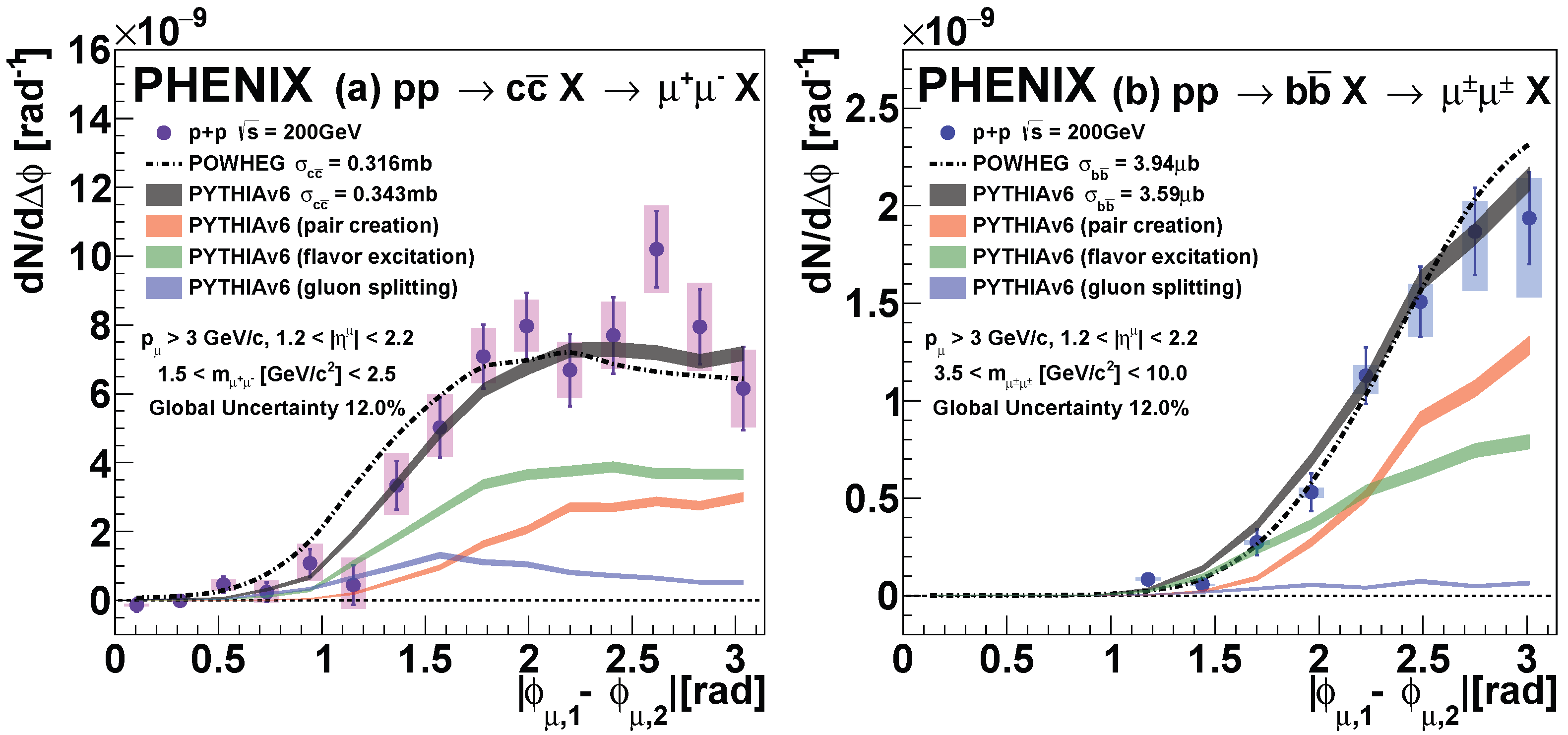
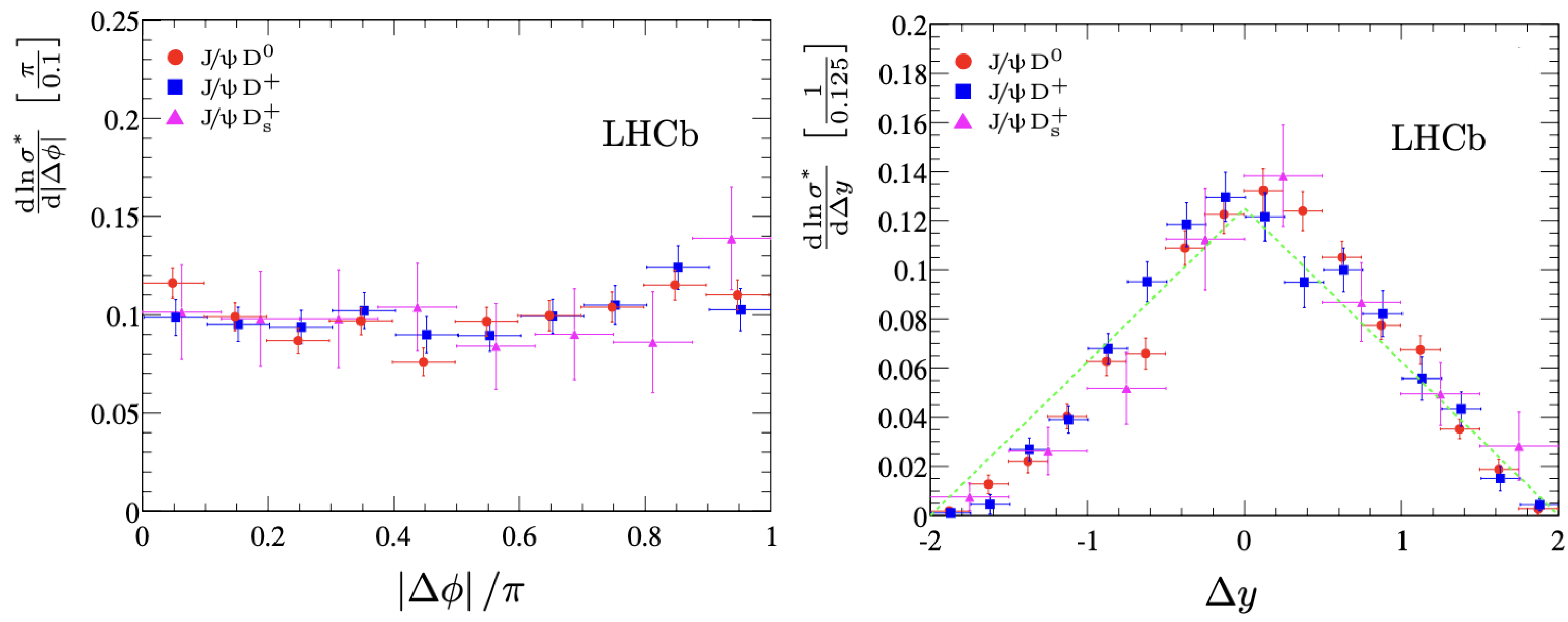
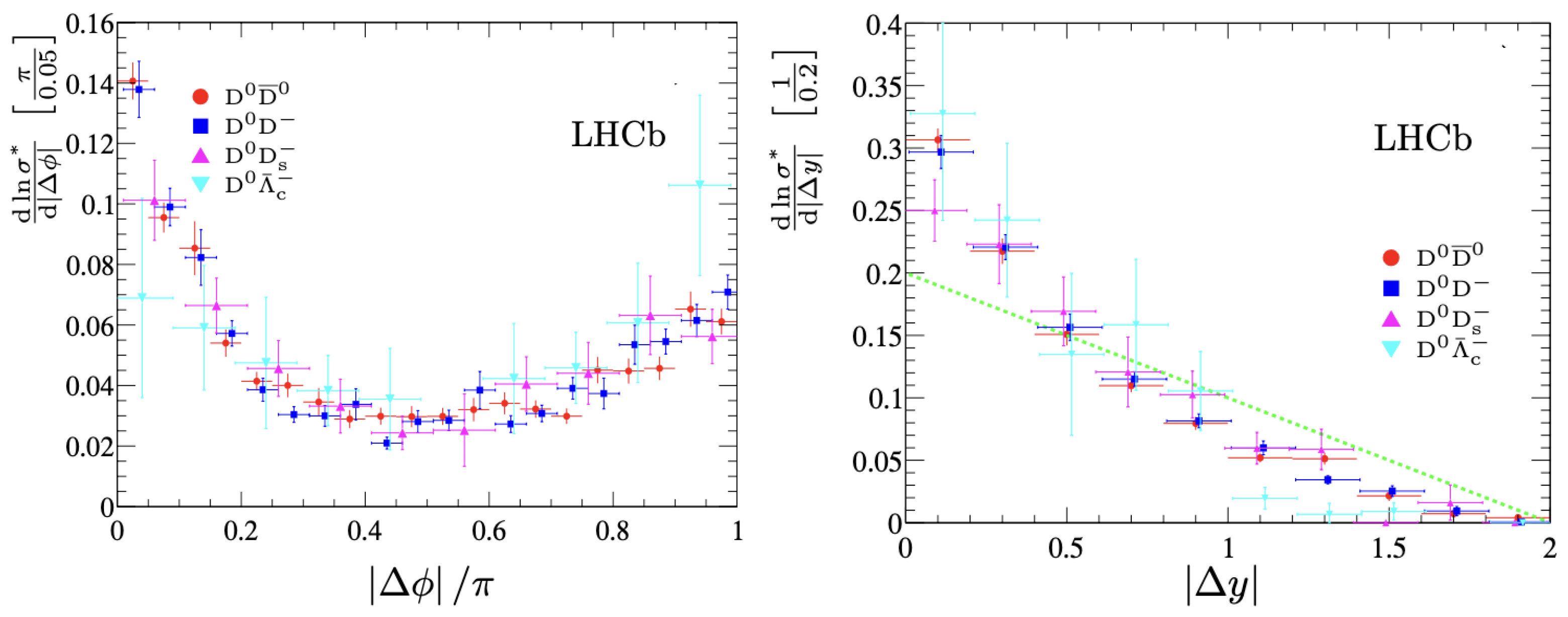
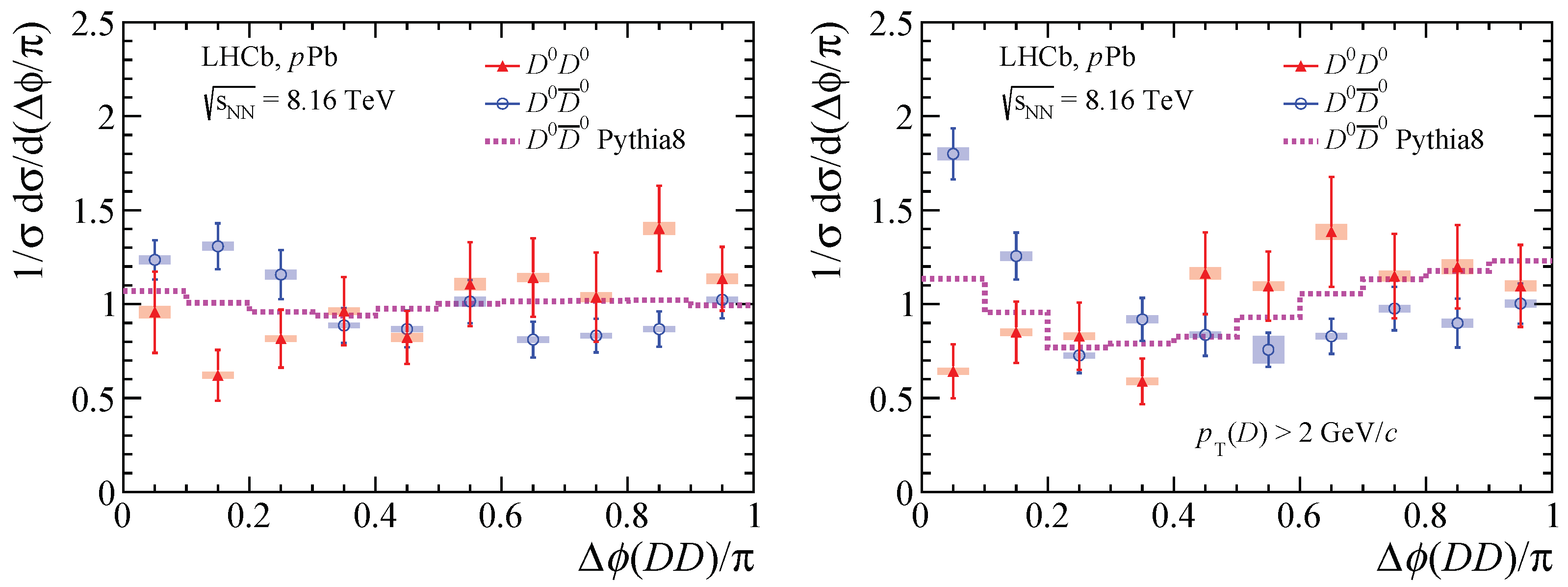
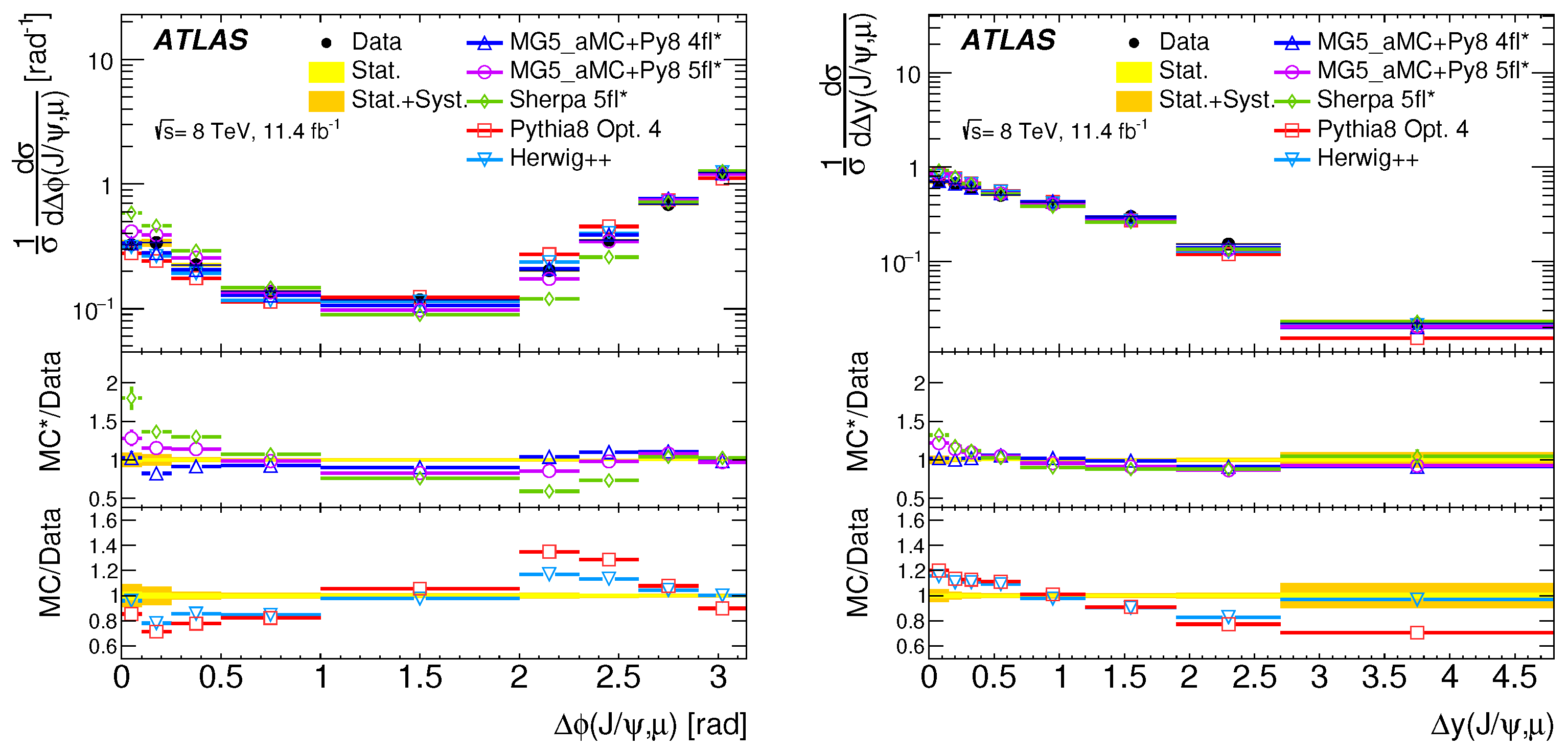
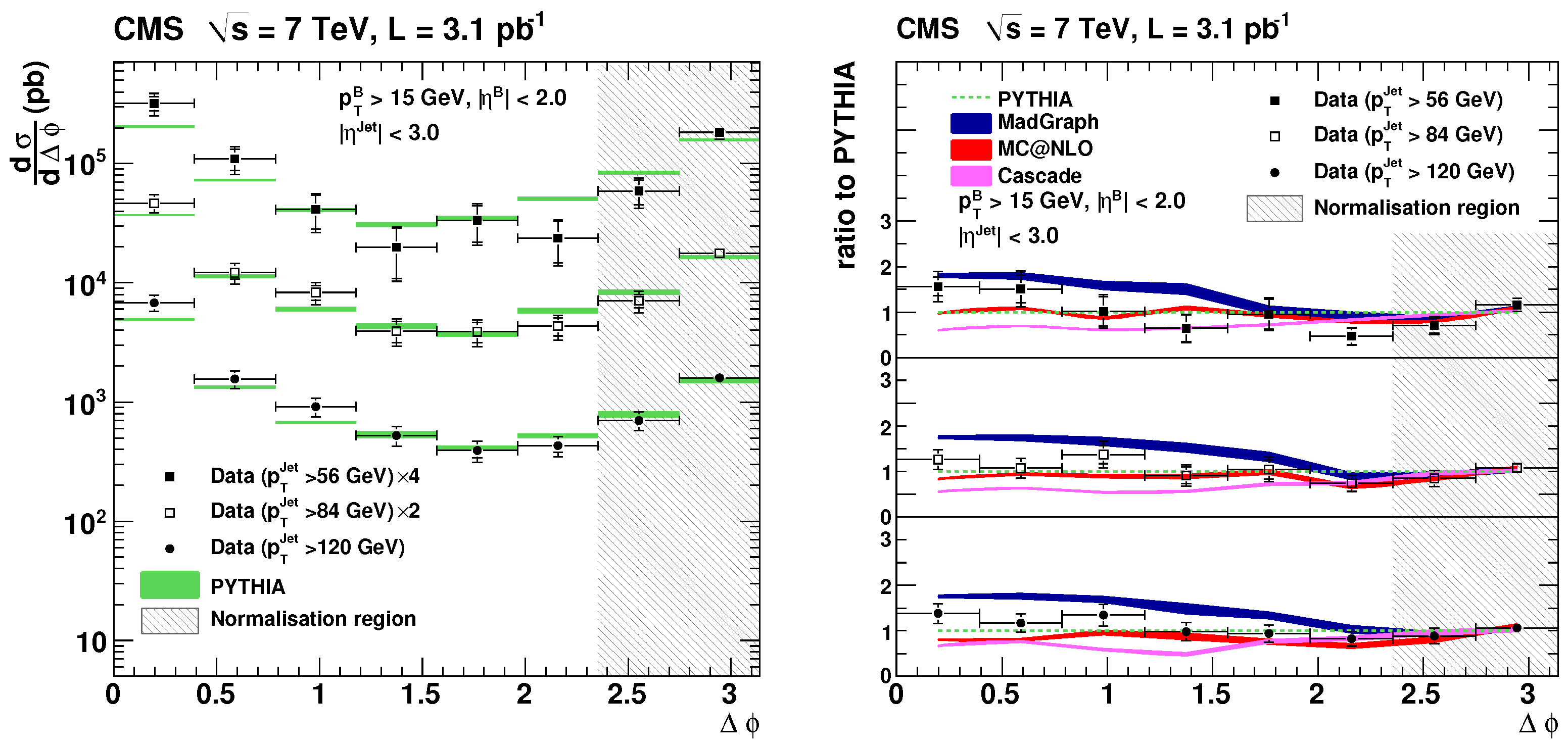

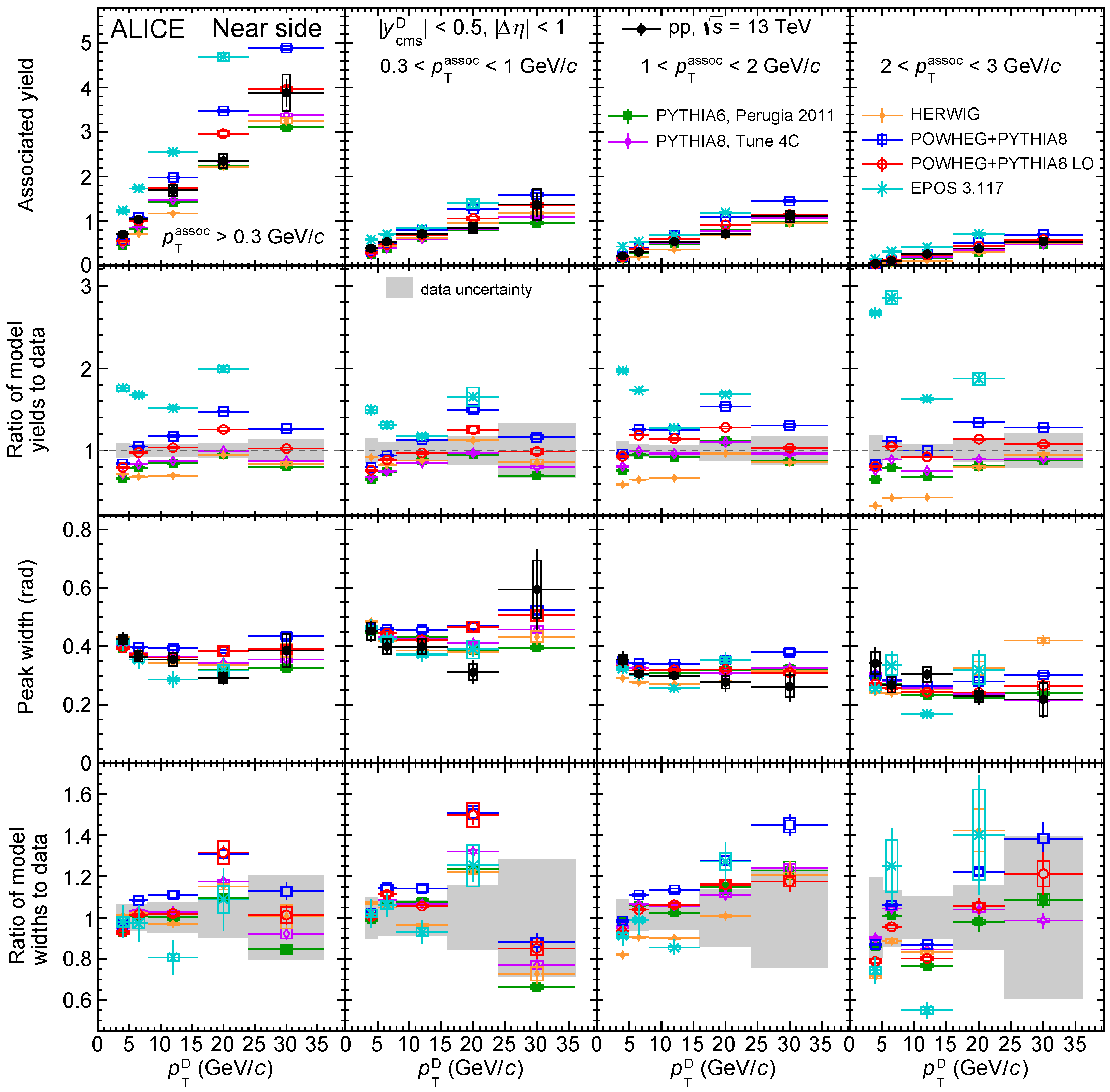

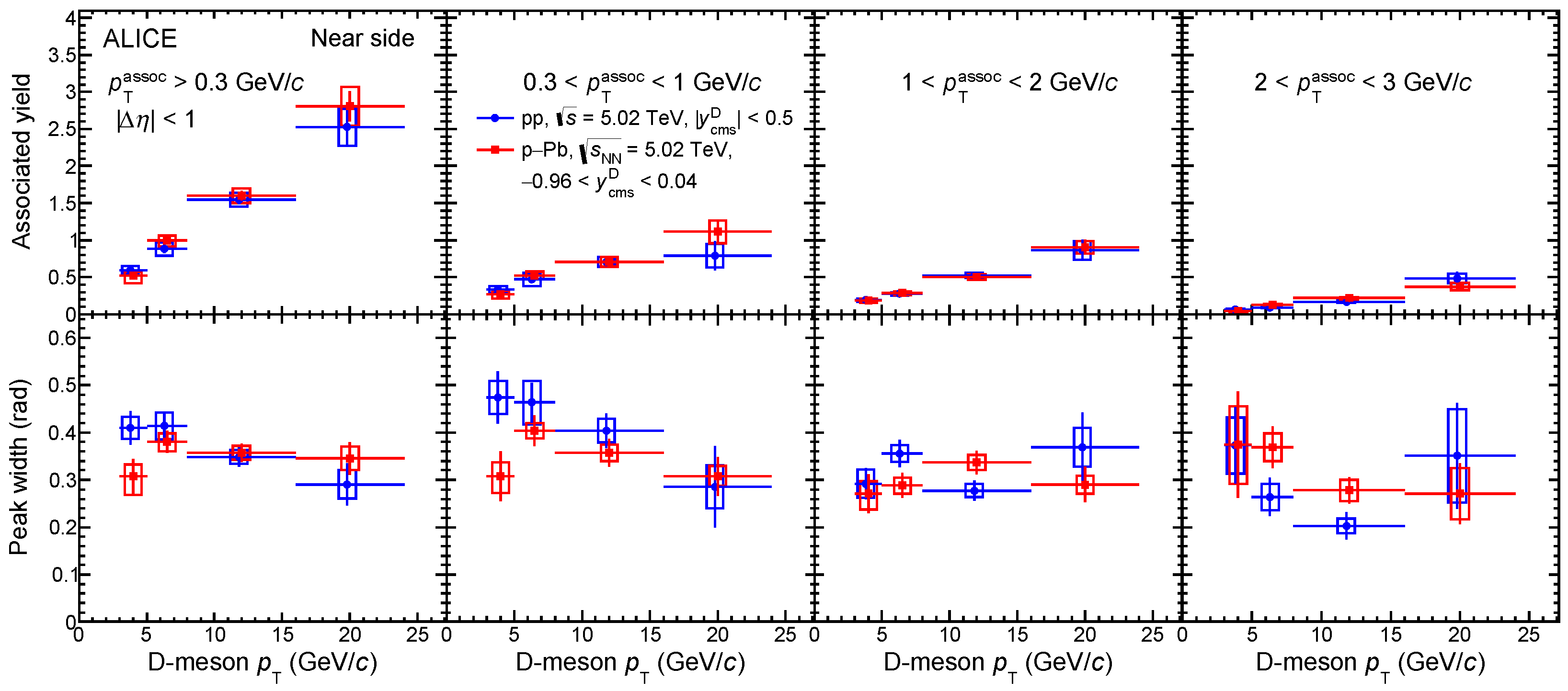

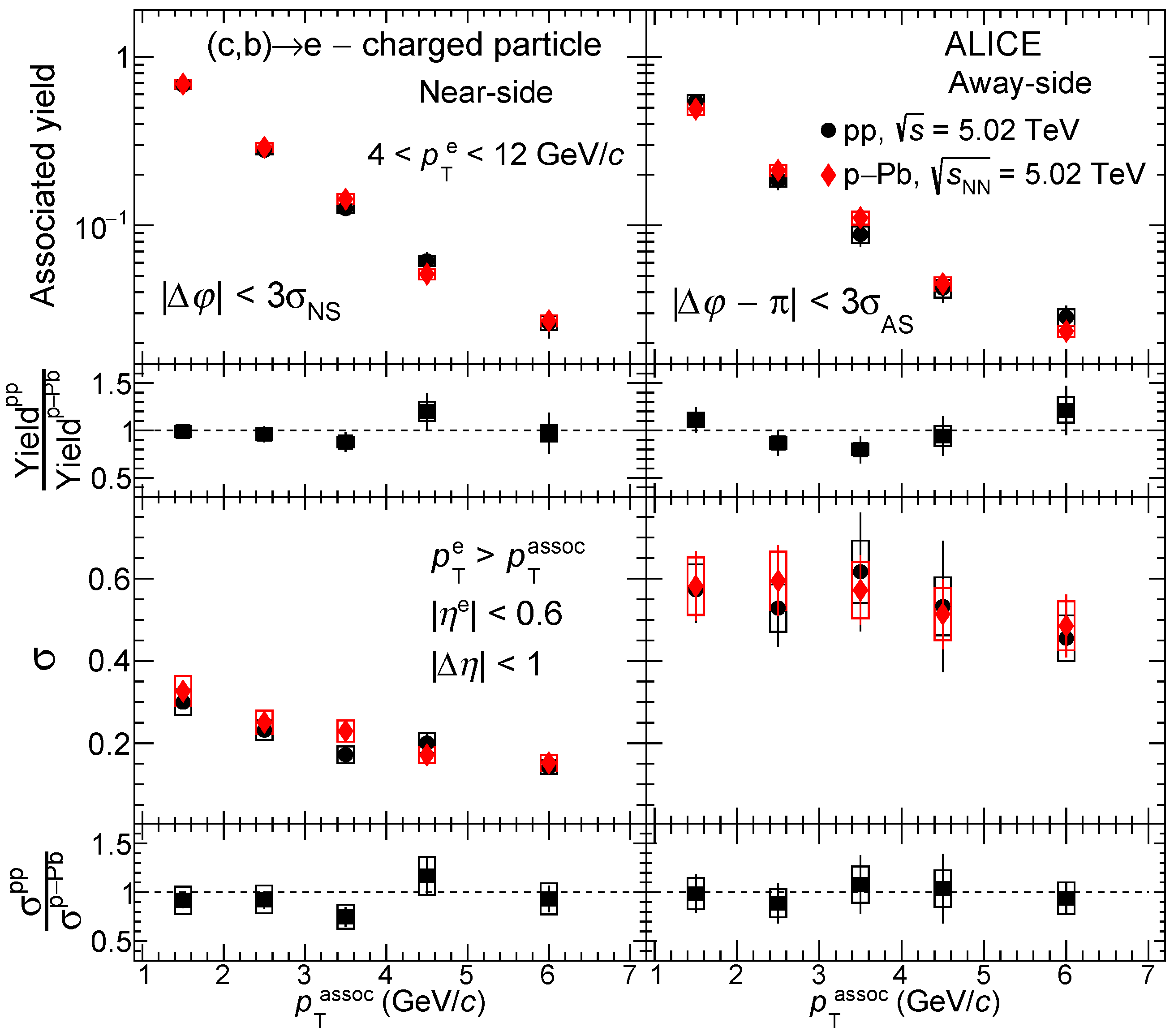
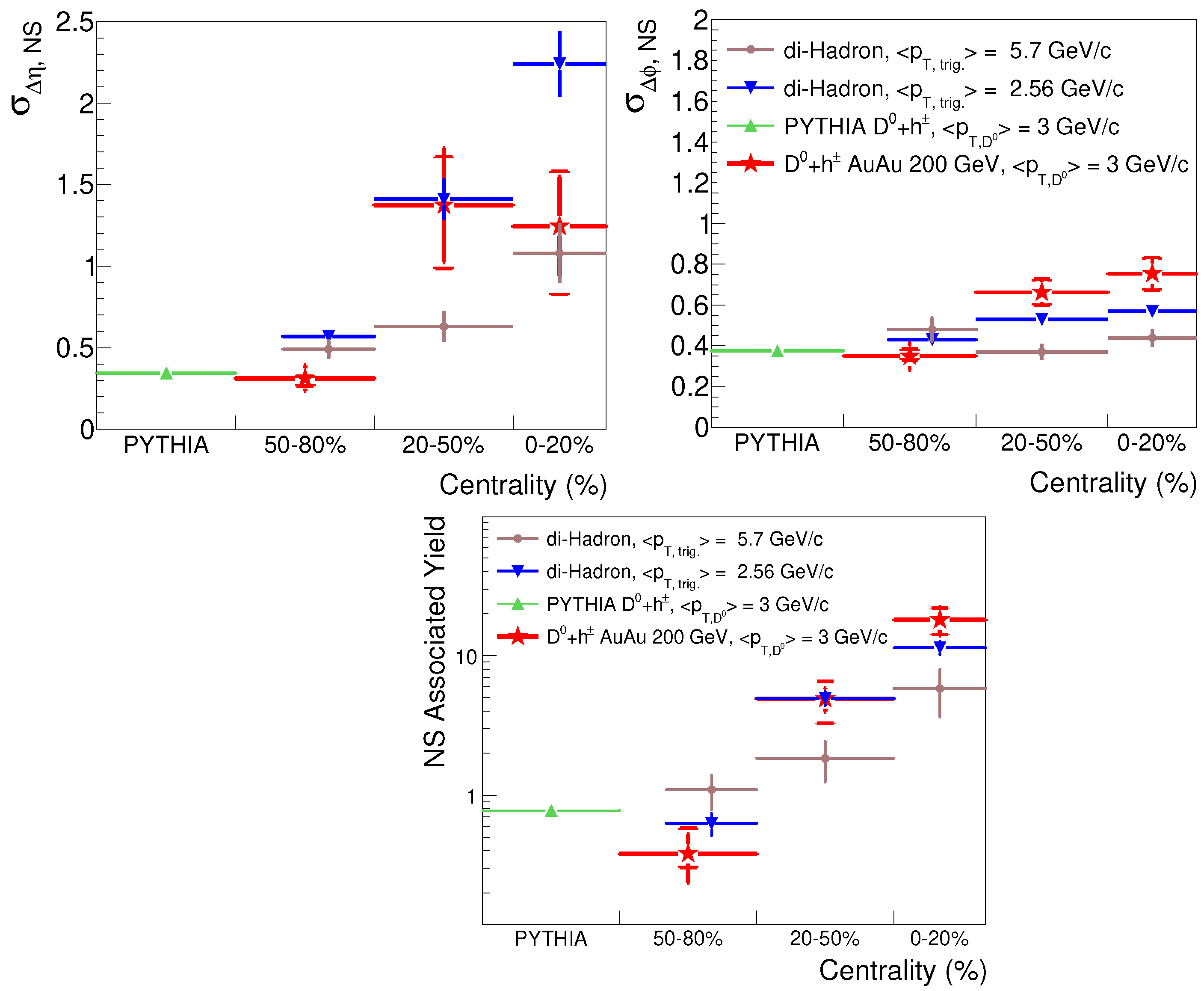
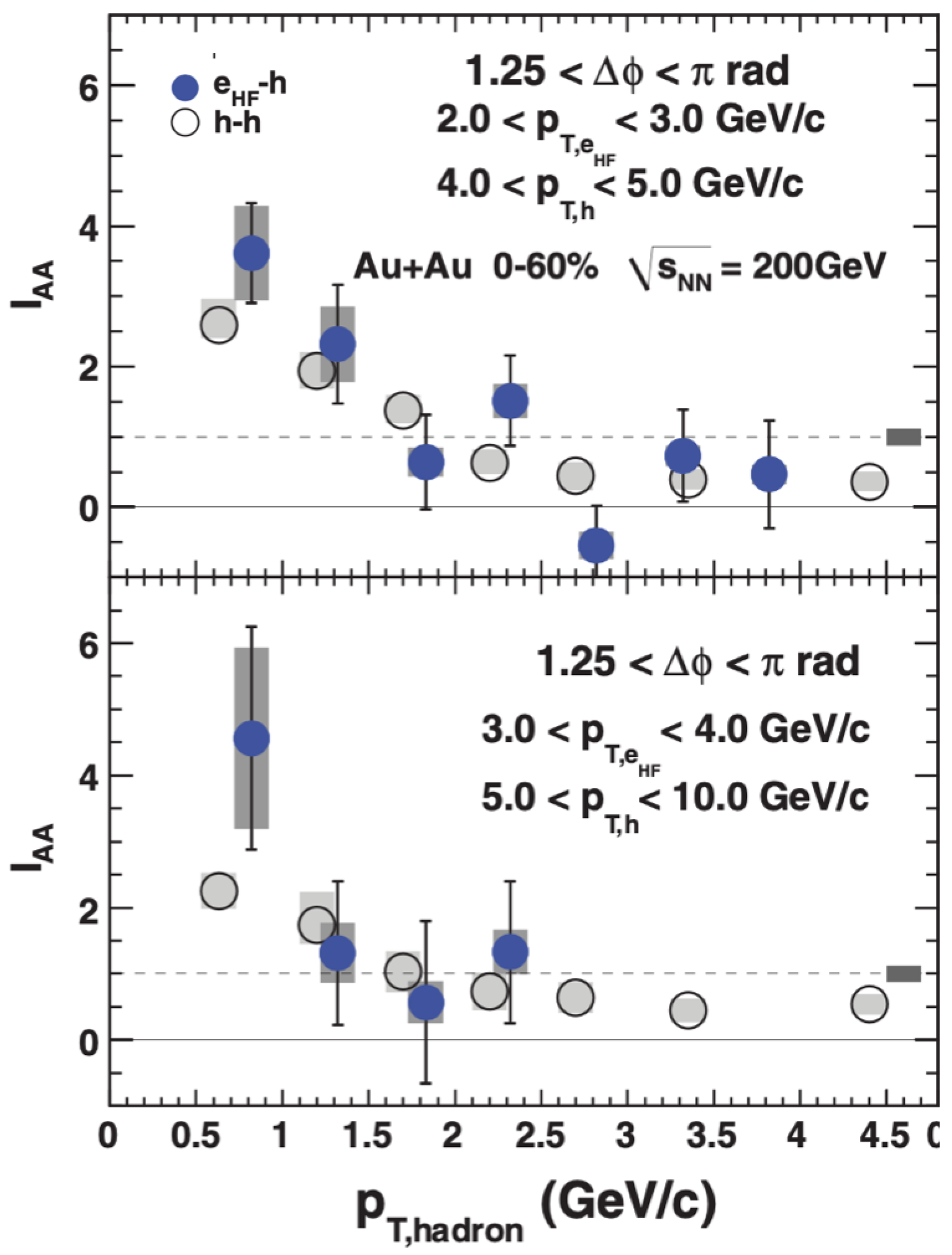




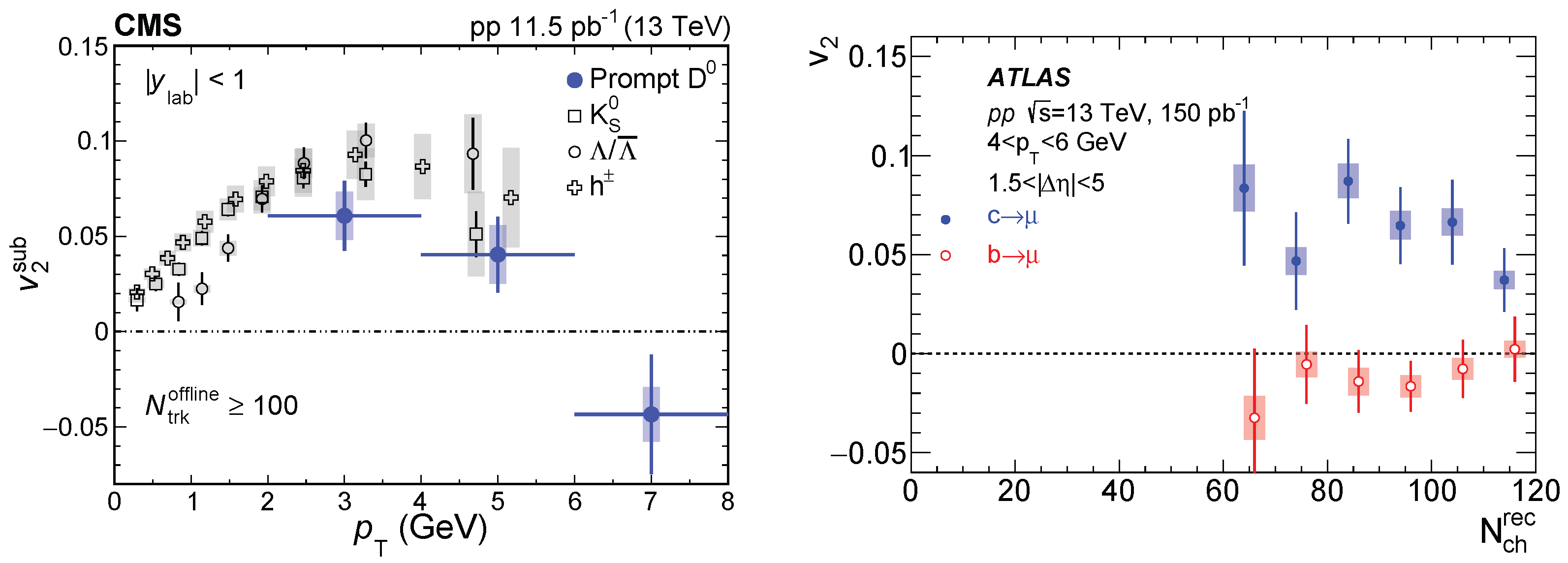
Disclaimer/Publisher’s Note: The statements, opinions and data contained in all publications are solely those of the individual author(s) and contributor(s) and not of MDPI and/or the editor(s). MDPI and/or the editor(s) disclaim responsibility for any injury to people or property resulting from any ideas, methods, instructions or products referred to in the content. |
© 2024 by the authors. Licensee MDPI, Basel, Switzerland. This article is an open access article distributed under the terms and conditions of the Creative Commons Attribution (CC BY) license (https://creativecommons.org/licenses/by/4.0/).
Share and Cite
Thomas, D.; Colamaria, F. Recent Findings from Heavy-Flavor Angular Correlation Measurements in Hadronic Collisions. Universe 2024, 10, 109. https://doi.org/10.3390/universe10030109
Thomas D, Colamaria F. Recent Findings from Heavy-Flavor Angular Correlation Measurements in Hadronic Collisions. Universe. 2024; 10(3):109. https://doi.org/10.3390/universe10030109
Chicago/Turabian StyleThomas, Deepa, and Fabio Colamaria. 2024. "Recent Findings from Heavy-Flavor Angular Correlation Measurements in Hadronic Collisions" Universe 10, no. 3: 109. https://doi.org/10.3390/universe10030109
APA StyleThomas, D., & Colamaria, F. (2024). Recent Findings from Heavy-Flavor Angular Correlation Measurements in Hadronic Collisions. Universe, 10(3), 109. https://doi.org/10.3390/universe10030109





